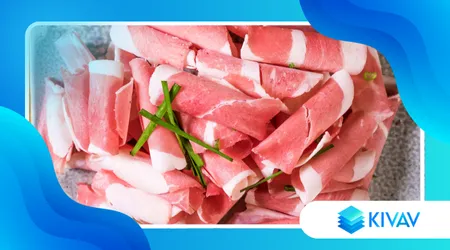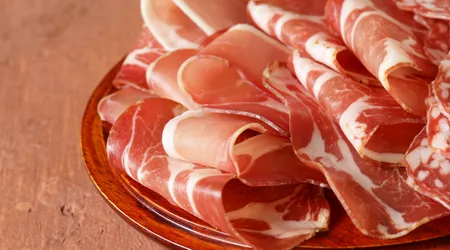Parma Ham DOP: history, production, and recommended pairings

Parma Ham DOP, a name that evokes tradition, taste and Italian culinary art, is much more than a simple cured meat: it is a symbol of excellence.
Announcements
This product, protected by the Protected Designation of Origin since 1996, represents the perfect combination of territory, artisanal knowledge and nature.
Its thousand-year history, rigorous production methods, and versatility in the kitchen make it an undisputed protagonist of world gastronomy.
In this article, we explore the roots of this delicacy, the process that makes it unique, the pairings that enhance its flavor and the secrets that make it a timeless icon.
Why does such a simple product—meat and salt—captivate palates around the world? Prepare to discover a sensory journey that begins in the hills of Parma and ends up on the most refined tables.
Announcements
The magic of the Parma Ham DOP It is born from a rare balance: a unique microclimate, expert hands, and a tradition that never yields to compromise.
Its unmistakable sweetness, delicate aroma and soft texture distinguish it from other raw hams.
This is not just a food, but a story of passion, patience, and respect for nature.
Through centuries of refinement, the Parma Ham Consortium has preserved a legacy that is now appreciated in over 90 countries.
Let's get ready to immerse ourselves in a world of flavors, where every slice is a story to be savored.
The Millennial History of Parma Ham DOP
The origins of the Parma Ham DOP They date back to Roman times, when Parma, the heart of Cisalpine Gaul, was famous for the skill of its pork butchers.
Cato the Censor, in the 2nd century BC, described salting techniques surprisingly similar to those of today.
Preserving pork legs in salt was a practical art, ideal for the Roman legions, who needed nutritious and long-lasting food.
An anecdote tells that Hannibal, after the victory in the battle of Trebbia (218 BC), was welcomed in Parma with salted pork legs, the forerunners of modern ham.
In the Middle Ages, production was organized under the guidance of the Arte dei Lardaroli, a specialized guild that separated from the butchers in 1459.
This marked the beginning of a professionalization that transformed ham into a renowned specialty.
Documents from the fourteenth century, such as the Cookbook, they mention Parma ham, a sign of its growing fame.
The proximity to the Salsomaggiore salt pans and the hilly climate favored the development of a unique tradition, capable of withstanding the centuries.
In 1963, the founding of the Parma Ham Consortium was a crucial step in protecting quality and authenticity.
In 1996, the European Union recognized the Parma Ham DOP, consecrating its status of excellence.
++ Cold Italian Pasta for Summer
Today, this cured meat is an ambassador of Made in Italy, with over 8.7 million hams produced in 2024, according to Consortium data.
Its history is an example of how tradition and innovation can coexist, keeping the soul of a product intact.
Legend has it that even Gioacchino Rossini, the famous composer, was an admirer of Parma ham, using it in his creative recipes.
This connection to Italian culture, from cuisine to music, makes prosciutto not just a food, but a symbol of identity.
Each slice is like a page from an ancient book, which tells of hard work, dedication, and love for the land.

The Production Process: Art and Nature in Balance
The production of the Parma Ham DOP it is a ritual that combines artisanal precision and unrepeatable natural conditions.
It all begins with the selection of pigs from breeds such as Large White, Landrace or Duroc, raised in ten regions of Central and Northern Italy.
The pigs, at least nine months old and weighing around 160 kg, are fed a diet of cereals and Parmigiano Reggiano whey, which gives the meat a sweetness.
After slaughter, the legs are chilled for 24 hours and trimmed into "chicken thigh" shapes. Salting, done exclusively with sea salt, is the heart of the process: no additives or preservatives are used.
The legs rest in cold storage for about a month, undergoing two salting phases. They are then washed and hung on racks to dry, in ventilated rooms that take advantage of Parma's microclimate.
The maturing process, which lasts at least 12 months, takes place in cellars where the dry, fragrant winds of the Parma hills shape the flavor.
See also: Pasta alla Gricia: The Mother of Carbonara
In the seventh month, suet, a mixture of pork fat, salt and pepper, is applied to protect the meat.
Before being branded with the Ducal Crown, experts perform a "probe" with a horse bone needle, evaluating the aroma. Only perfect hams receive the mark. Parma Ham DOP.
This process is analogous to creating a work of art: each step is a brush stroke that adds color and depth.
The production area, located south of the Via Emilia, is crucial: the wind that blows across the Apennines gives the ham its unique character.
In 2024, 140 companies produced this masterpiece, respecting a rigorous specification.
Traceability is a strong point: each ham bears tattoos and marks certifying its origin. This guarantees consumers an authentic product, the fruit of a controlled supply chain.
The Parma Ham DOP it's not just food, but an experience born from the synergy between man and nature.
Recommended Pairings: Enhance the Flavor
The Parma Ham DOP It's a versatile ingredient, capable of transforming a simple dish into a masterpiece. Traditionally, it's enjoyed thinly sliced, accompanied by bread or torta fritta parmigiana.
The classic pairing with melon is an explosion of contrasts: the sweetness of the fruit enhances the savory flavor of the prosciutto. Try, for example, melon and prosciutto skewers for a refined summer aperitif.
For an original touch, pair the ham with exotic fruits like papaya. A creative idea? A papaya carpaccio with Parma Ham DOP, seasoned with extra virgin olive oil and fresh mint.
This dish combines freshness and sophistication, perfect for an elegant dinner. Fresh figs are also an excellent choice, especially in autumn, when their ripe sweetness complements the delicate flavor of the prosciutto.
In the kitchen, prosciutto shines in sophisticated recipes. A risotto with figs and prosciutto is a perfect example of balanced flavors: the sweetness of the figs, the saltiness of the prosciutto, and the creaminess of the rice create a unique harmony.
For a quick appetizer, try some crostini with sheep's milk ricotta, prosciutto, and a drizzle of acacia honey: an explosion of flavor in a single bite.
For drinks, Lambrusco is a timeless pairing, with its bubbles that cleanse the palate.
Even a dry Sauvignon Blanc or Malvasia enhances the prosciutto's sweetness. Surprisingly, a light lager can be an excellent companion, as suggested by the Consortium.
The following table summarizes some winning combinations:
| Pairing | Description | Occasion |
|---|---|---|
| Melon and Ham | Sweet and salty contrast, fresh and classic | Summer aperitif |
| Figs and Ham | Mature, elegant and autumnal sweetness | Refined dinner |
| Risotto with Ham | Creamy, balanced, sophisticated | Sunday lunch |
| Crostini with Ricotta | Quick, tasty, with a touch of honey | Informal aperitif |
The versatility of the Parma Ham DOP This makes it a perfect ally in any season. Experiment with grilled vegetables, such as prosciutto-wrapped asparagus, for a light yet tasty dish.
Every pairing is an opportunity to celebrate simplicity that becomes excellence.
Nutritional Values and Their Role in the Modern Diet
The Parma Ham DOP It is not only a pleasure for the palate, but also a food with interesting nutritional properties.
Rich in high-quality protein, it's low in carbohydrates and mostly unsaturated fats. It's lactose-, gluten-, nitrate-, and nitrite-free, making it suitable for many diets.
According to CREA, a 50g portion (3-4 slices) provides protein, B vitamins, iron and zinc, with a moderate calorie intake.
This cured meat is ideal for athletes, thanks to the branched-chain amino acids (valine, leucine, isoleucine) which promote muscle recovery.
Its digestibility makes it suitable for children and the elderly. However, its sodium content requires moderation, especially for those following a low-sodium diet.
An occasional serving, as recommended by CREA, is a balanced way to enjoy it.
In the modern diet, Parma ham is considered a "luxury" food, to be consumed for pleasure without excess.
It can enhance a salad with arugula and Parmigiano Reggiano, transforming it into a complete meal. Its natural, additive-free ingredients meet the growing demand for wholesome foods.
It is an example of how tradition can dialogue with contemporary needs.
Sustainability is another strong point: the Consortium promotes breeding practices that respect animal welfare.
In 2024, 70% of farms adopted “antibiotic-free” standards, according to official data.
This makes ham not only a quality product, but also a model of responsibility towards the future.
Dúvidas Frequentes
1. What is the difference between Prosciutto di Parma DOP and other raw hams?
Prosciutto di Parma DOP stands out for its exclusive production in the province of Parma, the use of only salt, and natural curing.
Other hams, such as San Daniele, have different areas and techniques, influencing flavor and texture.
2. How to store Prosciutto di Parma DOP?
With the bone, it should be hung at 17-20°C; boneless, it should be refrigerated at 4-8°C for six months. Once cut, cover the exposed part with plastic wrap and refrigerate for a month.
3. Is Prosciutto di Parma DOP suitable for specific diets?
Yes, it is gluten-, lactose-, and additive-free, but the salt content requires moderation for those following a low-sodium diet.
4. Where to buy authentic Parma Ham DOP?
Look for the Ducal Crown mark and purchase from certified retailers or directly from Consortium producers to ensure authenticity.
This journey into the world of Parma Ham DOP reminds us that true luxury lies in carefully crafted simplicity.
Each slice is a tribute to tradition, a dialogue between past and present, an invitation to celebrate taste.
Whether on a rustic cutting board or in a Michelin-starred recipe, this ham continues to tell the story of Parma, its hills, and the passion of its artisans.
Try it, experiment, get inspired: the Parma Ham DOP It's not just food, it's an experience to be lived.
